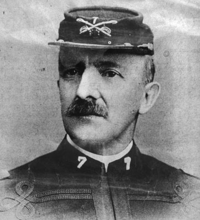Charles Varnum facts for kids
Quick facts for kids
Charles Albert Varnum
|
|
|---|---|
 |
|
| Born | June 21, 1849 Troy, New York |
| Died | February 26, 1936 (aged 86) Letterman Hospital in the Presidio of San Francisco |
| Place of burial | |
| Allegiance | United States of America |
| Service/ |
United States Army |
| Years of service | 1872–1908, 1912–1919 |
| Rank | |
| Unit | Company B, US 7th Cavalry |
| Battles/wars | Battle of the Little Bighorn Battle of Wounded Knee Drexel Mission Fight Philippine–American War World War I |
| Awards | Medal of Honor |
Charles Albert Varnum (born June 21, 1849 – died February 26, 1936) was an officer in the United States Army. He is best known for leading the scouts for George Armstrong Custer. This was during the Little Bighorn Campaign, part of the Great Sioux War. He was the last officer from that battle to die of natural causes. Varnum also received the Medal of Honor for his brave actions at the Drexel Mission Fight. This conflict happened after the Wounded Knee Massacre.
Contents
Early Life and Military Training
Charles Varnum was born in Troy, New York. His family was well-known for their military service. His father, John Varnum, was a major during the American Civil War. Later, his father moved to Pensacola, Florida, and became an important community leader.
Charles was chosen as a cadet from Florida to attend the United States Military Academy. He graduated on June 14, 1872. He was ranked 17th in his class of 57 students. After graduating, he became a second lieutenant. He then joined Company A of the U.S. 7th Cavalry Regiment in the Dakota Territory.
Adventures in the American West
Varnum took part in many trips and missions with his regiment. These included the Yellowstone Expedition in 1873. He also joined the Black Hills Expedition in 1874. His regiment was based at Fort Abraham Lincoln.
The Great Sioux War
In 1876, the Sioux Wars began again. Varnum and the 7th Cavalry traveled from Fort Lincoln to the Yellowstone River. Then they went to the mouth of the Rosebud River. Varnum was in charge of the scouts. These scouts included civilians, army personnel, Crow Indians, and Arikaree Indians. His job was to assign scouting missions. He also had to gather and organize their reports.
During the Little Bighorn expedition, Varnum and his scouts found a very large Indian village. It had hundreds of lodges. An Arikara scout named Red Star told Custer the news. He took Custer to a high point called the Crow's Nest. From there, he tried to show Custer the huge camp. But Custer could not see what his scouts were seeing.
Custer decided to attack, even though his scouts warned him. Some of Varnum's Indian scouts left. Others began singing their death songs and getting ready for battle. Several of them died in the fighting that followed. Varnum went with the troops led by Marcus Reno and Frederick Benteen. He survived the battle.
Life on the Frontier
After the battle, Varnum served as the Quartermaster for his regiment. This job lasted from November 1876 to October 1879. In 1877, he fought in the Nez Perce War. He was part of the Battle of Canyon Creek and the Battle of Bear Paw.
He continued to serve on the frontier at different forts. He married Mary Alice Moore (1865–1935). They had three children together. Sadly, one of their children died just two weeks after being born in 1889.
Medal of Honor and Later Career
In 1890, Captain Varnum commanded Company B of the 7th Cavalry. This was during the Wounded Knee Massacre on December 29. They were fighting against the Sioux Chief Big Foot and about 350 of his followers. The next day, during the Drexel Mission Fight, Varnum showed great bravery. His actions helped his troops safely retreat. For his courage, he received the Army Medal of Honor on September 22, 1897.
Varnum was promoted to major on February 1, 1901. Then he became a lieutenant colonel in April 1905. In September 1905, he sailed from San Francisco to the Philippines. He retired from the Regular Army due to disability on October 31, 1907. He continued to serve with Idaho militia troops for another year.
After leaving active service, he taught military science at the University of Maine. From 1912, he worked as a recruiting officer in the reserves. He was called back to active duty during World War I. He was promoted to Colonel and worked as a finance officer at Fort Mason, California. He retired again on April 8, 1919.
Final Years
Charles Varnum passed away in 1936 at Letterman Hospital. He was 86 years old. He was the last surviving officer who had fought in the Battle of the Little Bighorn. He was buried in the San Francisco National Cemetery.
Images for kids
-
Varnum received the Medal of Honor for his brave actions at Wounded Knee.


